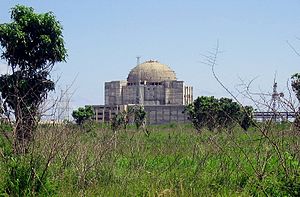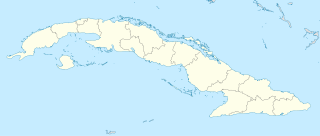Juraguá nuclear power plant
| Juraguá nuclear power plant | ||
|---|---|---|
| The ruins of the Juraguá nuclear power plant in 2006 | ||
| location | ||
|
|
||
| Coordinates | 22 ° 4 ′ 1 ″ N , 80 ° 30 ′ 33 ″ W | |
| Data | ||
| Owner: | Ministerio de la Industria Básica | |
| Operator: | Ministerio de la Industria Básica | |
| Project start: | 1967 | |
| Planning finished: | 1992/1997 | |
|
Construction discontinued (gross): |
2 (880 MW) | |
|
Planning set (gross): |
2 (880 MW) | |
| Was standing: | May 4, 2008 | |
| The data source of the respective entries can be found in the documentation . | ||
The unfinished Juraguá nuclear power plant (Spanish name: Central Electronuclear (CEN) de Juraguá ) is located near Juraguá near Cienfuegos , Cuba . In Cuba, the major project, which was carried out with significant financial and technical support from the Soviet Union , was described as a “work of the century”, to which the government attached great importance. At the height of the Cuban economic crisis after the collapse of the Soviet Union , Fidel Castro ordered the temporary interruption of the construction project in 1992 for cost reasons before his final assignment was announced in 2000.
history
Planning and start of construction
The history of the power plant goes back to 1976. The Soviet Academy of Sciences signed a contract with the Cuban Academy of Sciences for a research reactor that was supplied to Cuba by the Soviet Union. In 1976, Cuba signed a contract with the Soviet Union to build two 440-megawatt nuclear reactors of the VVER-440/318 series , an export version of the VVER-440/213, in the province of Cienfuegos. In the vicinity of the planned site, Cuba built a technical college for the training of workers and less qualified scientists to be employed in the power plant. The Faculty of Nuclear Science and Technology was established at Havana University . In 1981 a new type of building design was developed for the Juraguá power plant. In contrast to the standard version WWER-440/213, it should have containment . It relied on the experience gained in the construction of the Loviisa nuclear power plant . Had this design been successful, it would have resulted in a new VVER series. However, since the VVER-1000 was developed shortly afterwards , the new VVER-440 series was discarded, but the VVER-1000 received this containment.
Fidel Castro Díaz-Balart , the eldest son of the revolutionary leader and then President Fidel Castro, was responsible for the Cuban nuclear energy project from 1980 to 1992 . Castro junior, who studied nuclear physics in the Soviet Union and worked at the Moscow Kurchatov Institute , was director of the Cuban Atomic Energy Agency.
Construction of the power plant began in 1982 and most of the reactor parts, except for civil construction materials, were supplied by the Soviet Union under bilateral economic cooperation agreements. According to the plan, the first reactor would have gone into operation in 1993.
From 1982 the major project had its own television channel called "Tele-Nuclear", which documented the progress of the work and special events for public distribution.
Interruption of the project
The collapse of the Soviet Union, on which the Cuban nuclear program was technically and financially dependent, caused the project to fail. On September 5, 1992, Cuban President Fidel Castro announced that construction in Juraguá would be suspended because, at the height of its economic crisis, Cuba was unable to meet the financial conditions imposed by Russia. The cost of the reactors was $ 750 million. In 1993 the Russian government canceled about two-thirds of the debt. In the end, the Cuban government only had to pay a sixth because a third investor could be found who also took over a sixth. A report from September 1992 estimated that the first reactor was about 90 to 97% complete with 37% of the reactor interior, while the second reactor was only between 20 and 30% complete. If the first reactor had been completed, it would have covered over 15% of Cuban's energy needs and significantly reduced its dependence on imported oil.
Juraguá was one of three nuclear power plant projects in Cuba, but the only one to begin construction. The other two planned locations were Gibara (Holguín Province) in the east and Puerto Esperanza (Pinar del Río Province) in the west of the island. According to the 1978 agreement between the Soviet Union and Cuba, all three sites were to be equipped with four reactors each.
Approaches to resumption and permanent abandonment


In 1995 there was renewed discussion about resuming construction in Juraguá. The USA in particular believed that the reactors did not meet Western safety standards. The fact that Cuba had not yet signed the Nuclear Non-Proliferation Treaty at the time also raised concerns. In January 1997, Castro declared the project "postponed indefinitely". An examination of the reactor showed that 15% of the welds were faulty.
In November 1998 the International Atomic Energy Agency estimated the cost of possibly completing reactor 1 to be around $ 600 million.
During his state visit to Cuba, Russian President Vladimir Putin announced at a press conference in December 2000 that the nuclear power plant project in Juraguá had been finally suspended. Since then, the shell has no longer been preserved, but left to gradually deteriorate. In 2004, it was possible to reuse a transformer from the stock of the Juraguá power station ruins to restore the thermal power station "Antonio Guiteras" in Matanzas.
The Ciudad Nuclear settlement, which was built near the Juraguá construction site , was also no longer built as planned when the power plant project was completed. Numerous buildings were permanently in a semi-finished state. The former training center of the power plant project, located between Ciudad Nuclear and the power plant site, has served as a national training and certification center for various specialized industrial professions since 2000. This Centro Nacional para la Certificación Industrial "Julio César Castro Palomino" (CNCI) has been funded (as of 2015) with government funds from Canadian development cooperation and operated jointly with the Northern Alberta Institute of Technology (NAIT). In the first 15 years of its existence, over 11,000 Cubans took part in advanced training courses at the CNCI.
Data of the reactor blocks
The Juraguá nuclear power plant was to have four reactor blocks :
| Reactor block | Reactor type | net power |
gross power |
start of building | Project setting |
|---|---|---|---|---|---|
| Juraguá-1 | WWER-440 /318 | 417 MW | 440 MW | 10/01/1983 | 09/05/1992 |
| Juraguá-2 | WWER-440/318 | 417 MW | 440 MW | 02/01/1985 | 09/05/1992 |
| Juraguá-3 | WWER-440/318 | 408 MW | 440 MW | ||
| Juraguá-4 | WWER-440/318 | 408 MW | 440 MW |
literature
- Jonathan Benjamin-Alvarado: Power to the People: Energy and the Cuban Nuclear Program (PDF, 12.3 MB), Routledge: London and New York 2000, ISBN 0-415-92437-5 (English)
See also
Web links
- badische-zeitung.de , November 26, 2016, Philipp Lichterbeck, Marcel Kunzmann: Fidel Castro's planned nuclear power plant remained in ruins
- Leonid Leiva: folio.nzz.ch: Fidel's Hundred Fires (April 2011)
-
International Atomic Energy Agency , iaea.org: The Nuclear Safety Review 1997: Cuba (PDF, 25 kB) (English, document of the IAEA General Assembly on reactor safety in Juraguá)
- * Fidel Castro Díaz-Balart: Nuclear energy in Cuba: An indispensable link toward development (PDF, 162 kB), in: IAEA Bulletin 1/1990, pages 49–52 (English)
- James Gordon, dailymail.co.uk: Cuba's Soviet Legacy: Inside the Caribbean island's unfinished nuclear power station that lays just 180 miles off the Florida coast (with photos). In: Mail Online from October 13, 2014
- Fidel Castro, cuba.cu: Discurso pronunciado (...) en Cienfuegos el 5 de septiembre de 1992 Speech with detailed explanations on the interruption of the nuclear power plant project, website of the Cuban government (Spanish)
- youtube.com: Urban Exploration - Juragua Nuclear Power Plant (Cienfuegos, Cuba) - Walk through the power plant ruins, na vik, navik.de, May 14, 2014, video, with music (9:04)
swell
- Cuba's Juragua Nuclear Reactors ( Memento from February 11, 2003 in the Internet Archive )
- Cuba's Nuclear Reactors at Juragua (English)
- The reactors at Juaragua (English)
- Pictures of the power plant
- Will the Juragua Nuclear Power Station be Completed? (English)
Individual evidence
- ↑ a b NEI Source Book: Fourth Edition (NEISB_3.2) ( Memento from March 30, 2008 in the Internet Archive ) (English)
- ↑ General Conference of the IAEA: Record of the 236th plenary meeting (PDF, 31 kB), page 4, accessed on July 28, 2012 (English)
- ↑ a b Russia, Cuba, and the Juragua Nuclear Plant ( Memento from January 23, 2007 in the Internet Archive ) (English)
- ↑ Jonathan Benjamin-Alvarado and Alexander Belkin: CUBA'S NUCLEAR POWER PROGRAM AND POST-COLD WAR PRESSURES ( Memento from June 2, 2011 in the Internet Archive )
- ↑ Jonathan Benjamin-Alvarado: Power to the People: Energy and the Cuban Nuclear Program (PDF; 14.1 MB) page 39
- ↑ Cuba's Reach for the Stars. In: WOZ Die Wochenzeitung from January 21, 2016, accessed on May 17, 2016
- ↑ Cuba's unfinished power source - Cuba Politics News - Havana Journal (English)
- ↑ Cuba Cancels Atom Plant, Blaming Costs and Russians - The New York Times , September 7, 1992 (English)
- ^ Nuclear Safety: Concerns with the Nuclear Power Reactors in Cuba. (GAO / T-RCED-95-236, Aug. 1, 1995). (English; PDF; 887 kB)
- ^ Nuclear Safety: Concerns with the Nuclear Power Reactors in Cuba. (GAO / T-RCED-95-236, Aug. 1, 1995). (PDF; 887 kB)
- ↑ Robert Windrem: Cuba's unfinished power source, in: NBC News of October 21, 2003, accessed via Havana Journal on February 2, 2015 (English)
- ↑ International Atomic Energy Agency: Management of delayed nuclear power plant projects (PDF, 38 kB), IAEA-TECDOC-1110, Appendix 1, page 67, Vienna 1999, accessed on July 28, 2012 (English)
- ↑ Ángel Tomás González: Cuba y Rusia reeditan su romance, in: El Mundo of July 11, 2014, accessed on February 2, 2015 (Spanish)
- ↑ María Julia Mayoral: Detallada información al pueblo sobre los problemas en el servicio eléctrico, in: Granma of September 28, 2004, accessed on February 2, 2015 (Spanish)
- ↑ NAIT celebrates 15 years of working with Cuba. NAIT website, report from September 29, 2015, accessed on February 1, 2018 (English)
- ^ Certificar es de sabios. In: Trabajadores of June 10, 2015, accessed on May 17, 2016 (Spanish)
- ↑ Juragua 1 in the PRIS of the IAEA ( Memento from June 4, 2011 in the Internet Archive )
- ↑ Juragua 2 in the PRIS of the IAEA ( Memento from June 4, 2011 in the Internet Archive )
- ↑ Juragua 3 in the PRIS of the IAEA ( Memento from June 4, 2011 in the Internet Archive )
- ↑ Juragua 4 in the PRIS of the IAEA ( Memento from June 4, 2011 in the Internet Archive )

